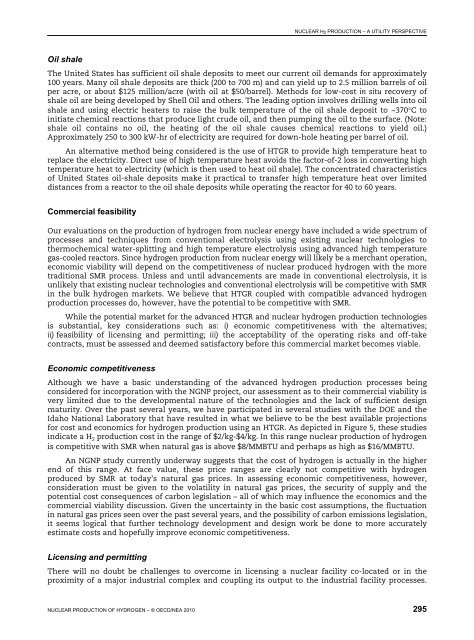Nuclear Production of Hydrogen, Fourth Information Exchange ...
Nuclear Production of Hydrogen, Fourth Information Exchange ...
Nuclear Production of Hydrogen, Fourth Information Exchange ...
Create successful ePaper yourself
Turn your PDF publications into a flip-book with our unique Google optimized e-Paper software.
NUCLEAR H 2 PRODUCTION – A UTILITY PERSPECTIVE<br />
Oil shale<br />
The United States has sufficient oil shale deposits to meet our current oil demands for approximately<br />
100 years. Many oil shale deposits are thick (200 to 700 m) and can yield up to 2.5 million barrels <strong>of</strong> oil<br />
per acre, or about $125 million/acre (with oil at $50/barrel). Methods for low-cost in situ recovery <strong>of</strong><br />
shale oil are being developed by Shell Oil and others. The leading option involves drilling wells into oil<br />
shale and using electric heaters to raise the bulk temperature <strong>of</strong> the oil shale deposit to ~370°C to<br />
initiate chemical reactions that produce light crude oil, and then pumping the oil to the surface. (Note:<br />
shale oil contains no oil, the heating <strong>of</strong> the oil shale causes chemical reactions to yield oil.)<br />
Approximately 250 to 300 kW-hr <strong>of</strong> electricity are required for down-hole heating per barrel <strong>of</strong> oil.<br />
An alternative method being considered is the use <strong>of</strong> HTGR to provide high temperature heat to<br />
replace the electricity. Direct use <strong>of</strong> high temperature heat avoids the factor-<strong>of</strong>-2 loss in converting high<br />
temperature heat to electricity (which is then used to heat oil shale). The concentrated characteristics<br />
<strong>of</strong> United States oil-shale deposits make it practical to transfer high temperature heat over limited<br />
distances from a reactor to the oil shale deposits while operating the reactor for 40 to 60 years.<br />
Commercial feasibility<br />
Our evaluations on the production <strong>of</strong> hydrogen from nuclear energy have included a wide spectrum <strong>of</strong><br />
processes and techniques from conventional electrolysis using existing nuclear technologies to<br />
thermochemical water-splitting and high temperature electrolysis using advanced high temperature<br />
gas-cooled reactors. Since hydrogen production from nuclear energy will likely be a merchant operation,<br />
economic viability will depend on the competitiveness <strong>of</strong> nuclear produced hydrogen with the more<br />
traditional SMR process. Unless and until advancements are made in conventional electrolysis, it is<br />
unlikely that existing nuclear technologies and conventional electrolysis will be competitive with SMR<br />
in the bulk hydrogen markets. We believe that HTGR coupled with compatible advanced hydrogen<br />
production processes do, however, have the potential to be competitive with SMR.<br />
While the potential market for the advanced HTGR and nuclear hydrogen production technologies<br />
is substantial, key considerations such as: i) economic competitiveness with the alternatives;<br />
ii) feasibility <strong>of</strong> licensing and permitting; iii) the acceptability <strong>of</strong> the operating risks and <strong>of</strong>f-take<br />
contracts, must be assessed and deemed satisfactory before this commercial market becomes viable.<br />
Economic competitiveness<br />
Although we have a basic understanding <strong>of</strong> the advanced hydrogen production processes being<br />
considered for incorporation with the NGNP project, our assessment as to their commercial viability is<br />
very limited due to the developmental nature <strong>of</strong> the technologies and the lack <strong>of</strong> sufficient design<br />
maturity. Over the past several years, we have participated in several studies with the DOE and the<br />
Idaho National Laboratory that have resulted in what we believe to be the best available projections<br />
for cost and economics for hydrogen production using an HTGR. As depicted in Figure 5, these studies<br />
indicate a H 2 production cost in the range <strong>of</strong> $2/kg-$4/kg. In this range nuclear production <strong>of</strong> hydrogen<br />
is competitive with SMR when natural gas is above $8/MMBTU and perhaps as high as $16/MMBTU.<br />
An NGNP study currently underway suggests that the cost <strong>of</strong> hydrogen is actually in the higher<br />
end <strong>of</strong> this range. At face value, these price ranges are clearly not competitive with hydrogen<br />
produced by SMR at today’s natural gas prices. In assessing economic competitiveness, however,<br />
consideration must be given to the volatility in natural gas prices, the security <strong>of</strong> supply and the<br />
potential cost consequences <strong>of</strong> carbon legislation – all <strong>of</strong> which may influence the economics and the<br />
commercial viability discussion. Given the uncertainty in the basic cost assumptions, the fluctuation<br />
in natural gas prices seen over the past several years, and the possibility <strong>of</strong> carbon emissions legislation,<br />
it seems logical that further technology development and design work be done to more accurately<br />
estimate costs and hopefully improve economic competitiveness.<br />
Licensing and permitting<br />
There will no doubt be challenges to overcome in licensing a nuclear facility co-located or in the<br />
proximity <strong>of</strong> a major industrial complex and coupling its output to the industrial facility processes.<br />
NUCLEAR PRODUCTION OF HYDROGEN – © OECD/NEA 2010 295

















